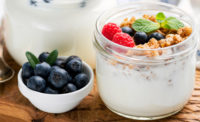Tap into the capabilities of bacterial cultures for dairy
Many of today’s cultures, especially for yogurt, can also provide mild flavors and thick, creamy textures.

Bacteria have never had a greater role in cultured dairy products than today. It used to be that companies purchased cultures only for the types of flavors and rate of acid production needed, but now they can add texture development and health benefits to the list.
With clean-label products being especially important for many consumers, selecting a culture to provide the most functionality with fewer ingredients will contribute even more value to your new products.
Add texture and mouthfeel
The traditional way to add texture and mouthfeel to a cultured product such as yogurt or sour cream is by adding ingredients such as cream, nonfat dry milk, whey protein concentrate, hydrocolloids and/or starch. Cream, of course, will provide the best mouthfeel and flavor.
If adding fat is not desirable, then using starches and hydrocolloids has been a common practice. But adding ingredients can increase cost and also increases the length of an ingredient statement. Some consumers would love to see a yogurt label that has only milk and cultures listed on it.
Many of today’s cultures, especially for yogurt, can provide mild flavors and thick, creamy textures. They are called lactic acid bacteria, and the ones that are required for yogurt — Lactobacillus bulgaricus and Streptococcus thermophiles — can have enhanced capabilities.
Some of these strains are extracellular-polymeric-substance (EPS) producing, which means they have the ability to produce exopolysaccharides. These exopolysaccharides can improve the viscosity and mouthfeel while also reducing syneresis in yogurt.
One study published in 2016 by Ipsen et al. in LWT-Food Science and Technology combined EPS-producing cultures with added whey protein concentrate or particulated whey protein. Researchers found that yogurt made with EPS-producing cultures combined with 1% additional protein, from either source of whey protein, provided a smoother texture and better stability than the cultures alone.
Improving health
Cultured dairy products provide good nutrition because they start with milk. The cultures, once ingested, are beneficial to your gastrointestinal track (GIT) because they can help you digest the lactose you are consuming with the yogurt.
Probiotics mean “for life” in Latin and are by definition “live microorganisms which when administered in adequate amounts confer a health benefit on the host.” These microorganisms are deemed probiotic through clinical studies.
Our GIT can have up to 1,000 bacterial species and up to 100 trillion microbial cells, all of which play a key role in digestion and immune defense. Probiotic effects are strain-specific, and documented strains come from species of Lactobacillus, Bifidobacterium, Propionibacterium and Saccharomyces.
Specific strains from these organisms can have positive effects on your GIT health, immunity and even more. Adding probiotics to yogurt works well because the probiotics can grow and remain live and active during the normal shelf life of yogurt.
Imagine a yogurt that combines a probiotic with EPS-producing cultures and extra protein from whey, and you will have a yogurt with a clean label, great texture and added health benefits.
Looking for a reprint of this article?
From high-res PDFs to custom plaques, order your copy today!







